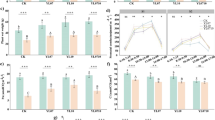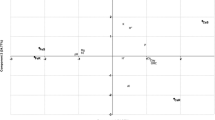Abstract
Aims
In this work, the effects of fertilization on diazotroph diversity and plant growth promoting traits were analyzed. An interaction model was then suggested and tested in field.
Methods
One hundred and ninety bacterial strains were isolated from rhizospheric soil and roots of rice cropped in three different fertilization conditions. Phosphate solubilization, indolic compound (IC) and siderophore production, and nitrogen fixation abilities of the isolates were screened and compared. Some isolates were selected for in vivo plant growth promotion in greenhouse and field experiments.
Results
We found that fertilization had a limited effect on diversity but had a major effect on phosphate solubilization and IC production abilities. We demonstrated that plants select bacteria that present good phosphate solubilization ability for intimate root association in lieu of good IC production under nutrient-poor conditions and select good IC producers in lieu of good phosphate solubilizers under nutrient-moderate conditions. In nutrient-rich conditions, this selection preference seems to be deactivated. In the field trial, good phosphate solubilizers only contributed effectively to plant growth at nutrient-poor conditions and good IC producers only contributed to plant growth at nutrient-moderate conditions.
Conclusions
Fertilization affects the PGP traits of the diazotrophic community. These findings may be used for directed PGPR prospection and anticipated PGPR candidate selection.




Similar content being viewed by others
References
Adesemoye AO, Kloepper JW (2009) Plant-microbes interactions in enhanced fertilizer-use efficiency. Appl Microbiol Biotechnol 85(1):1–12. doi:10.1007/s00253-009-2196-0
Adesemoye AO, Torbert HA, Kloepper JW (2009) Plant growth-promoting rhizobacteria allow reduced application rates of chemical fertilizers. Microb Ecol 58(4):921–9. doi:10.1007/s00248-009-9531-y
Ahemad M, Khan MS (2011) Effects of insecticides on plant-growth-promoting activities of phosphate solubilizing rhizobacterium Klebsiella sp. strain PS19. Pest Biochem Physiol 100(1):51–56. doi:10.1016/j.pestbp.2011.02.004
Ahmad F, Ahmad I, Khan MS (2005) Indole acetic acid production by the indigenous isolates of azotobacter and fluorescent pseudomonas in the presence and absence of tryptophan. Turk J Biol 29:29–34
Altschul SF, Madden TL, Schaeffer AA, Zhang J, Zhang Z, Miller W, Lipman DJ (1997) Gapped BLAST and PSI-BLAST: a new generation of protein database search programs. Nucleic Acids Res 25:3389–3402
Alves BJR, Boddey RM, Urquiaga S (2003) The success of BNF in soybean in Brazil. Plant Soil 252(1):1–9
Ambrosini A, Beneduzi A, Stefanski T, Pinheiro FG, Vargas LK, Passaglia LMP (2012) Screening of plant growth promoting rhizobacteria isolated from sunflower (Helianthus annuus L.). Plant Soil 356(1):245–264. doi:10.1007/s11104-011-1079-1
Babalola OO (2010) Beneficial bacteria of agricultural importance. Biotechnol Lett 32(11):1559–70. doi:10.1007/s10529-010-0347-0
Baldani JI, Baldani VLD, Seldin L, Döbereiner J (1986) A root- associated nitrogen-fixing bacterium. Int J Syst Bacteriol 36(1):86–93
Beneduzi A, Peres D, Beschoren P, Zanettini MHB, Passaglia LMP (2008) Genetic and phenotypic diversity of plant-growth-promoting bacilli isolated from wheat fields in southern Brazil. Res Microbiol 159:244–250. doi:10.1016/j.resmic.2008.03.003
Berg G, Smalla K (2009) Plant species and soil type cooperatively shape the structure and function of microbial communities in the rhizosphere. FEMS Microbiol Ecol 68:1–13. doi:10.1111/j.1574-6941.2009.00654.x
Bianco C, Defez R (2010) Improvement of phosphate solubilization and Medicago plant yield by an indole-3-acetic acid-overproducing strain of Sinorhizobium meliloti. Appl Environ Microbiol 76(14):4626–32. doi:10.1128/AEM.02756-09
Boddey RM (1987) Methods for quantification of nitrogen fixation associated with gramineae. Crit Rev Plant Sci 6:209–266
Burris RH (1972) Nitrogen fixation assay methods and techniques. Methods Enzymol 24:415–431
Carlier E, Rovera M, Jaume RA, Rosas SB (2008) Improvement of growth, under field conditions, of wheat inoculated with Pseudomonas chlororaphis subsp. aurantiaca SR1. World J Microbiol Biotechnol 24(11):2653–2658. doi:10.1007/s11274-008-9791-6
Chatli AS, Beri V (2008) Isolation and characterisation of phosphate solubilising microorganisms from the cold desert habitat of Salix alba Linn. in trans Himalayan region of Himachal Pradesh. Indian. J Microbiol 48(2):267–273
Döbereiner J (1988) Isolation and identification of root associated diazotrophs. Plant Soil 110(2):207–212
Enwall K, Philippot L, Hallin S (2005) Activity and composition of the denitrifying bacterial community respond differently to long-term fertilization. Appl Environ Microbiol 71(12):8335–8343. doi:10.1128/AEM.71.12.8335
FAO (2011) “Energy-smart” food for people and climate: Issue paper. Food and Agriculture Organization of the United Nations, Rome
Farina R, Beneduzi A, Ambrosini A, de Campos SB, Lisboa BB, Wendisch V et al (2012) Diversity of plant growth-promoting rhizobacteria communities associated with the stages of canola growth. Appl Soil Ecol 55:44–52. doi:10.1016/j.apsoil.2011.12.011
Glick B, Penrose D, Li J (1998) A model for the lowering of plant ethylene concentrations by plant growth-promoting bacteria. J Theor Biol 190(1):63–8. doi:10.1006/jtbi.1997.0532
Glickmann E, Dessaux Y (1995) A critical examination of the specificity of the Salkowski reagent for indolic compounds produced by phytopathogenic bacteria. Appl Environ Microbiol 61:793–796
Good AG, Beatty PH (2011) Fertilizing nature: a tragedy of excess in the commons. PLoS Biol 9(8):e1001124. doi:10.1371/journal.pbio.1001124
Hayat R, Ali S, Amara U, Khalid R, Ahmed I (2010) Soil beneficial bacteria and their role in plant growth promotion: a review. Ann Microbiol 60(4):579–598. doi:10.1007/s13213-010-0117-1
Hoagland DR, Snyder WC (1933) Nutrition of strawberry plants under controlled conditions. Proc Am Soc Hortic Sci 30:288–294
Hu J, Lin X, Wang J, Chu H, Yin R, Zhang J (2009) Population size and specific potential of P-mineralizing and -solubilizing bacteria under long-term P-deficiency fertilization in a sandy loam soil. Pedobiologia 53(1):49–58. doi:10.1016/j.pedobi.2009.02.002
Hu XJ, Li ZJ, Cao YC, Zhang J, Gong YX, Yang YF (2010) Isolation and identification of a phosphate-solubilizing bacterium Pantoeastewartii subsp. stewartii g6, and effects of temperature, salinity, and pH on its growth under indoor culture conditions. Aquacult Int 18(6):1079–1091. doi:10.1007/s10499-010-9325-8
Inselsbacher E, Wanek W, Ripka K, Hackl E, Sessitsch A, Strauss J, Zechmeister-Boltenstern S (2010) Greenhouse gas fluxes respond to different N fertilizer types due to altered plant-soil-microbe interactions. Plant Soil 343(1–2):17–35. doi:10.1007/s11104-010-0597-6
Islam R, Trivedi P, Madhaiyan M, Seshadri S, Lee G, Yang J, Kim Y et al (2009) Isolation, enumeration, and characterization of diazotrophic bacteria from paddy soil sample under long-term fertilizer management experiment. Biol Fertil Soils 46(3):261–269. doi:10.1007/s00374-009-0425-4
Lebuhn M, Heulin T, Hartmann A (1997) Production of auxin and other indolic and phenolic compounds by Paenibacillus polymixa strains isolated from different proximity to plant roots. FEMS Microbiol Ecol 22:325–344. doi:10.1111/j.1574-6941.1997.tb00384.x
Liu XZ, Zhang LM, Prosser JI, He JZ (2009) Abundance and community structure of sulfate reducing prokaryotes in a paddy soil of southern China under different fertilization regimes. Soil Biol Biochem 41(4):687–694. doi:10.1016/j.soilbio.2009.01.001
Miransari M (2011) Soil microbes and plant fertilization. Appl Microbiol Biotechnol 92(5):875–85. doi:10.1007/s00253-011-3521-y
Nautiyal CS (1999) An efficient microbiological growth medium for screening phosphate solubilizing microorganisms. FEMS Microbiol Lett 170(436):265–270
Pariona-Llanos R, Ferrara FIS, Gonzales HHS, Barbosa HR (2010) Influence of organic fertilization on the number of culturable diazotrophic endophytic bacteria isolated from sugarcane. Eur J Soil Biol 46(6):387–393. doi:10.1016/j.ejsobi.2010.08.003
Piceno Y, Lovell C (2000) Stability in natural bacterial communities: I. Nutrient addition effects on rhizosphere diazotroph assemblage composition. Microb Ecol 39(1):32–40. doi:10.1007/s002489900192
Rodgers-Gray BS, Shaw MW (2001) The effect of incorporating straw or manure into the soil on the natural microflora of winter wheat. Plant Pathol 50(5):537–545. doi:10.1046/j.1365-3059.2001.00598.x
Schwyn B, Neilands JB (1987) Universal chemical assay for the detection and determination of siderophores. Anal Biochem 160:47–56
Seldin L, van Elsas JD, Penido EGC (1983) Bacillus nitrogens fixers from Brazilian soils. Plant Soil 70:243–255
Simpson RJ, Oberson A, Culvenor RA, Ryan MH, Veneklaas EJ, Lambers H et al (2011) Strategies and agronomic interventions to improve the phosphorus-use efficiency of farming systems. Plant Soil 342(1–2):89–120. doi:10.1007/s11104-011-0880-1
Sokolova MG, Akimova GP, Vaishlya OB (2011) Effect of phytohormones synthesized by rhizosphere bacteria on plants. Appl Biochem Microbiol 47(3):274–278. doi:10.1134/S0003683811030148
Trivedi P, Kumar B, Pandey A, Palni LMS (2007) Growth promotion of rice by phosphate solubilizing bioinoculants in a Himalayan location. Dev Plant Soil Sci 102:291–299
Wartiainen I (2008) Variation in the active diazotrophic community in rice paddy—nifH PCR-DGGE analysis of rhizosphere and bulk soil. Appl Soil Ecol 39(1):65–75. doi:10.1016/j.apsoil.2007.11.008
Yim WJ, Poonguzhali S, Madhaiyan M, Palaniappan P, Siddikee MA, Sa T (2009) Characterization of plant-growth promoting diazotrophic bacteria isolated from field grown Chinese cabbage under different fertilization conditions. J Microbiol 47(2):147–155. doi:10.1007/s12275-008-0201-4
Yuan CL, Mou CX, Wu WL, Guo YB (2010) Effect of different fertilization treatments on indole-3-acetic acid producing bacteria in soil. J Soils Sediment 11(2):322–329. doi:10.1007/s11368-010-0315-2
Zabihi HR, Savaghebi GR, Khavazi K, Ganjali A, Miransari M (2010) Pseudomonas bacteria and phosphorous fertilization, affecting wheat (Triticum aestivum L.) yield and P uptake under greenhouse and field conditions. Acta Physiol Plant 33(1):145–152. doi:10.1007/s11738-010-0531-9
Zar J (2010) Biostatistical analysis, 5th edn. Pearson, New Jersey
Acknowledgements
We thank to Sídia Callegari Jacques for her valuable scientific comments. This work was financed by a Grant and fellowships from Conselho Nacional de Desenvolvimento Científico e Tecnológico (CNPq/Brazil) and INCT da Fixação Biológica do Nitrogênio (Brazil).
Author information
Authors and Affiliations
Corresponding author
Additional information
Responsible Editor: Timothy Cavagnaro.
Electronic supplementary materials
Below is the link to the electronic supplementary material.
Fig. S1
Parametric (3 X 2 factorial ANOVA after square root transformation) analysis of mean (±SD) phosphate SI according to fertilization condition and bacterial origin. Fertilization and bacterial origin had a significant interaction effect (p = 0.001), as A bacteria showed a higher phosphate SI than R bacteria on Z condition (p = 0.020) and R bacteria showed a higher phosphate SI than A bacteria in L condition (p = 0.002). At H condition, both A and R bacteria presented a similar phosphate SI (p = 0.985). Z = unfertilized, L = light fertilization, H = heavy fertilization, A = root-associated bacteria, R = rhizospheric bacteria. (JPEG 870 kb)
Fig. S2
Mean score for the siderophores SI (a) and Nase activity (b) according to bacterial origin and fertilization condition. Means (±1SE) with different letters are significantly different (p < 0.05 in the Kruskal-Wallis with Dunn’s post hoc test). ZR = unfertilized rhizospheric bacteria, ZA = unfertilized root-associated bacteria, LR = light fertilization rhizospheric bacteria, LA = light fertilization root-associated bacteria, HR = heavy fertilization rhizospheric bacteria, and HA = heavy fertilization root-associated bacteria. (JPEG 800 kb)
Table S1
(DOCX 15 kb)
Table S2
(DOCX 16 kb)
Table S3
(DOCX 16 kb)
Table S4
(DOCX 18 kb)
Table S5
(DOCX 16 kb)
Rights and permissions
About this article
Cite this article
da Costa, P.B., Beneduzi, A., de Souza, R. et al. The effects of different fertilization conditions on bacterial plant growth promoting traits: guidelines for directed bacterial prospection and testing. Plant Soil 368, 267–280 (2013). https://doi.org/10.1007/s11104-012-1513-z
Received:
Accepted:
Published:
Issue Date:
DOI: https://doi.org/10.1007/s11104-012-1513-z




